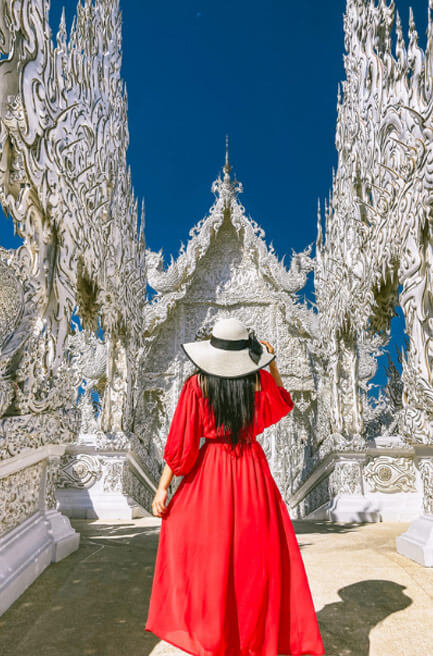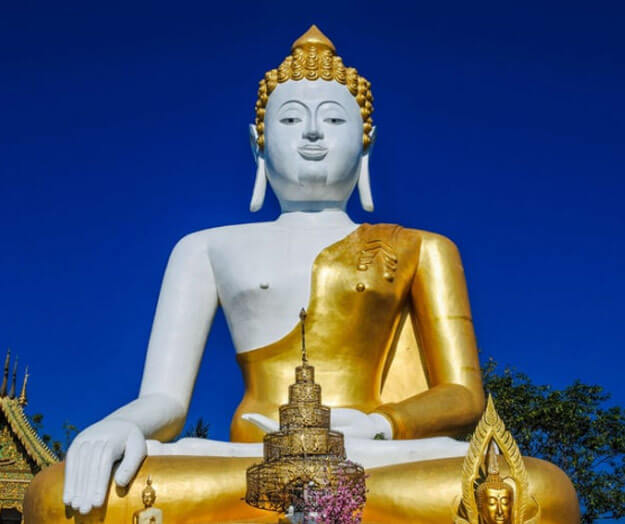Nestled in the northernmost corner of Thailand lies Chiang Rai, an unspoiled jewel of Southeast Asia that beckons to the discerning traveler. While it may live in the shadow of its more famous neighbor, Chiang Mai, Chiang Rai boasts its own unique charm, a realm where verdant landscapes, profound cultural heritage, and a touch of mystique come together to create an enchanting destination that remains refreshingly untrammeled by the masses.
Chiang Rai: Thailand’s Enigmatic Northern Gem
Chiang Rai, named after the confluence of the Ruak and Mekong Rivers, is a province brimming with captivating history and natural beauty. This region, sharing borders with Myanmar and Laos, was once notorious for opium production but has since undergone a transformation. Today, Chiang Rai stands as a testament to cultural authenticity and serene landscapes.
Nestled in the northernmost reaches of Thailand, Chiang Rai is a destination that embodies the essence of the country’s rich history, diverse culture, and breathtaking natural beauty. Known for its mystical temples, serene landscapes, and unique culture, Chiang Rai offers travelers an authentic Thai experience away from the bustling crowds of Bangkok and the well-trodden paths of other popular Thai destinations.
Population and Demographics: Chiang Rai is the capital of the province of Chiang Rai and serves as a gateway to exploring Thailand’s Golden Triangle region, where Thailand, Myanmar, and Laos converge. As of my last knowledge update in September 2021, the city had a population of approximately 200,000 people. The demographics of Chiang Rai are predominantly Thai, but you’ll also encounter various ethnic minorities, such as the Akha, Lisu, and Karen tribes, each contributing to the area’s cultural tapestry.
Historical and Cultural Significance: Chiang Rai’s history is deeply intertwined with the Lanna Kingdom, which flourished in northern Thailand from the 13th to the 18th century. The city was founded in 1262 by King Mengrai, who also established the nearby city of Chiang Mai. This historical connection is evident in the architecture, art, and traditions of Chiang Rai, making it a hub for those interested in Thailand’s historical and cultural heritage.
Points of Interest: Chiang Rai’s charm lies in its blend of traditional and modern attractions. While it’s less crowded than some of Thailand’s other tourist hubs, it offers a wealth of experiences for visitors. Some noteworthy points of interest include:
Wat Rong Khun (White Temple): Perhaps the most iconic site in Chiang Rai, this stunning temple is a contemporary masterpiece of Thai artistry, designed by artist Chalermchai Kositpipat. Its intricate white facade sparkles in the sunlight, symbolizing purity and enlightenment.
Wat Phra Singh: A historic temple in the heart of the city, Wat Phra Singh houses a revered Buddha image and exemplifies classic Lanna architecture.
Golden Triangle: A boat ride along the Mekong River provides the opportunity to visit the Golden Triangle, where you can see the borders of Thailand, Myanmar, and Laos. This area was historically associated with the opium trade and offers a unique perspective on the region’s history.
Doi Tung Royal Villa: Once the residence of the late Princess Mother Srinagarindra, this beautifully landscaped villa offers insights into the royal family’s commitment to improving the lives of hill tribe communities.

Chiang Mai Thailand
Must-Visit Attractions
Must-Visit Attractions and Landmarks in Chiang Rai
Chiang Rai’s allure extends beyond its temples and historical sites. You can’t miss exploring the vibrant night markets, indulging in local cuisine, or embarking on trekking adventures in the lush mountains. Don’t forget to visit the Hill Tribe villages to immerse yourself in the cultures of the local ethnic groups.
1. Wat Rong Khun (The White Temple)
Arguably the most iconic landmark in Chiang Rai, the White Temple is a breathtaking work of art that seems to emerge from the realms of fantasy. Designed by the acclaimed Thai artist Chalermchai Kositpipat, this stunning temple is a fusion of traditional Thai architecture and contemporary artistry. The immaculate white exterior adorned with intricate mirror work and the surreal sculptures make it a must-visit attraction.
2. Wat Phra Singh
Located in the heart of Chiang Rai, Wat Phra Singh is another remarkable temple that showcases exquisite Lanna-style architecture. The temple’s beautifully detailed interiors and serene courtyards offer a peaceful escape from the bustling city.
3. The Golden Triangle
A visit to Chiang Rai wouldn’t be complete without exploring the Golden Triangle, where the borders of Thailand, Myanmar, and Laos meet. This historically significant area is not only a scenic wonder but also a place to learn about the opium trade’s intriguing past.
4. Doi Tung Royal Villa
Set amidst the enchanting Doi Tung mountains, the Doi Tung Royal Villa is a testament to the Thai royal family’s dedication to sustainable development in the region. The beautifully landscaped gardens and the villa’s intriguing history make it a captivating visit.
How to Get To Chiang Rai
Chiang Rai is well-connected both domestically and internationally, making it easily accessible for travelers. You have several options to reach this enchanting city:
By Air: The most convenient way to get to Chiang Rai is by flying into Mae Fah Luang-Chiang Rai International Airport (CEI). This airport has frequent flights from Bangkok’s Suvarnabhumi Airport and other major cities in Thailand.
By Bus: Chiang Rai is accessible by long-distance buses from various cities in Thailand, including Bangkok, Chiang Mai, and Phitsanulok. The bus journey can be quite long, so it’s advisable to book a comfortable VIP bus if you choose this option.
By Car: If you prefer a more flexible travel schedule, you can rent a car and drive to Chiang Rai. The roads are well-maintained, and the drive offers the chance to explore the scenic countryside.
Best Time To Go Chiang Rai
The best time to visit Chiang Rai largely depends on your weather and crowd preferences:
Cool, Dry Season (November to February): This is the most popular time to visit when the weather is pleasantly cool and dry. It’s ideal for outdoor activities, temple visits, and exploring the city.
Hot Season (March to June): This period can be scorching, with temperatures often exceeding 35°C (95°F). If you can tolerate the heat, you may find fewer tourists during this time.
Rainy Season (July to October): While the rain can be refreshing, heavy downpours and occasional flooding can disrupt travel plans. However, the landscape is lush and green during this season.
Best Way To Get Around
Getting around Chiang Rai is relatively straightforward, with several transportation options:
Tuk-Tuks: Tuk-tuks are a fun and affordable way to explore the city. Negotiate the fare before hopping in, as they don’t typically use meters.
Taxis: Metered taxis are available in Chiang Rai, and they are a more comfortable option for longer journeys or if you’re traveling with a group.
Rental Scooters: If you’re comfortable riding a scooter, this can be a convenient way to explore the city and its surroundings. Just remember to wear a helmet and drive cautiously.
Rental Cars: Renting a car is a great option if you plan to venture into the countryside or explore Chiang Rai at your own pace. International and local car rental agencies operate in the city.
Off the Beaten Path Hidden Gems
While Chiang Rai’s popular attractions are undoubtedly captivating, there are hidden gems waiting to be discovered:
Huay Mae Sai Waterfall: Tucked away in the jungle, this serene waterfall is perfect for a refreshing dip. It’s a bit of a trek to reach but well worth the effort.
Bamboo Rafting on the Kok River: Escape the crowds and embark on a tranquil bamboo rafting journey along the Kok River. You’ll be surrounded by lush greenery and enjoy a peaceful experience.
Phu Chi Fah: If you’re an early riser, make the journey to Phu Chi Fah for a breathtaking sunrise view. This mountain offers panoramic vistas of the mist-covered hills.

Ayutthaya Thailand
Local Cuisine / Best Restaurants?
Exploring Chiang Rai’s culinary scene is a delightful adventure. Northern Thai cuisine, known as “Lanna cuisine,” is a highlight. Some must-try dishes include:
Khao Soi: A fragrant and creamy curry noodle soup topped with crispy noodles.
Som Tam: A spicy papaya salad that’s a burst of flavors.
Sticky Rice: Served with various dips and accompaniments, sticky rice is a staple.
For the best dining experiences, visit local markets like the Night Bazaar and sample street food. Additionally, here are a few renowned restaurants:
Cabbages & Condoms: Known for its creative decor and excellent Thai food.
Nong Beer Restaurant: A popular spot for authentic Lanna cuisine.
Chivit Thamma Da Coffee House: Offers a mix of Thai and Western dishes in a beautiful setting.
Activities in Chiang Rai
Chiang Rai offers a wide range of activities to cater to different interests:
Hill Tribe Visits: Take a culturally enriching journey to the nearby hill tribe villages to learn about their way of life and traditions.
Festivals: Depending on the time of year, you might have the chance to experience local festivals like Songkran (Thai New Year) or the Yi Peng Lantern Festival.
Traditional Markets: Explore the bustling markets of Chiang Rai, such as the Night Bazaar, to shop for souvenirs, handicrafts, and local products.
Unique Cultural Experiences
To immerse yourself in the local culture, consider these experiences:
Monk Chat: Engage in a monk chat session at a local temple to learn about Buddhism and the daily life of monks.
Thai Cooking Classes: Join a cooking class to master the art of Thai cuisine and prepare dishes like a local.
Temple Etiquette: When visiting temples, remember to dress modestly, remove your shoes before entering buildings, and be respectful of religious customs.
Language
Local Language of Chiang Rai
While Thai is the official language, you’ll find that English is spoken to varying degrees in tourist areas. Learning a few basic Thai phrases can enhance your travel experience and show respect for the local culture.
Accommodation in Chiang Rai
Accommodation in Chiang Rai
Chiang Rai offers a variety of accommodation options to suit different budgets:
Luxury Resorts: Experience world-class comfort at resorts like Anantara Golden Triangle Elephant Camp & Resort.
Mid-Range Hotels: Chiang Rai has numerous mid-range hotels offering comfortable stays, such as The Legend Chiang Rai Boutique River Resort & Spa.
Budget Guesthouses: If you’re traveling on a tight budget, guesthouses and hostels like Mercy Hostel provide affordable options.
Boutique Stays: Discover unique boutique hotels that offer a personalized and charming atmosphere.
Pattaya Thailand
How's the weather in Chiang Rai?
Chiang Rai, located in northern Thailand, experiences a tropical monsoon climate. The weather in Chiang Rai can be broadly categorized into three seasons:
Cool Season (November to February):
- This is the most popular time to visit Chiang Rai as the weather is pleasantly cool and dry.
- Daytime temperatures range from 15°C (59°F) to 30°C (86°F), making it comfortable for outdoor activities and exploring.
- Nights can be chilly, especially in December and January, with temperatures dropping to 8°C (46°F) or lower.
- This is the peak tourist season, so expect larger crowds and higher prices for accommodations.
Hot Season (March to May):
- The hot season in Chiang Rai is characterized by high temperatures and low humidity.
- Daytime temperatures can soar above 35°C (95°F) in April, making it the hottest month.
- It’s advisable to stay hydrated and protect yourself from the sun if visiting during this period.
- While it’s still possible to explore Chiang Rai, some travelers find the heat uncomfortable for outdoor activities.
Rainy Season (June to October):
- Chiang Rai experiences its monsoon season during this period.
- Rainfall is common, and you can expect frequent and sometimes heavy downpours.
- The countryside becomes lush and green, making it a beautiful time for nature enthusiasts.
- Be prepared for occasional disruptions to outdoor plans due to rain.
- Temperatures during the rainy season range from 20°C (68°F) to 32°C (89°F).
It’s important to note that Chiang Rai’s weather can be unpredictable, and conditions may vary from year to year. When planning your visit, consider the season that best aligns with your preferences for weather and outdoor activities. Many travelers prefer the cool season for its comfortable temperatures and clear skies.
Recommended Itinerary
1 Week in Chiang Rai
Here’s a sample itinerary for a week-long trip to Chiang Rai:
Day 1: Arrive in Chiang Rai, settle into your accommodation, and explore the Night Bazaar for dinner.
Day 2: Visit Wat Rong Khun (The White Temple) early in the morning to beat the crowds. In the afternoon, explore Wat Phra Singh and the city center.
Day 3: Take a day trip to the Golden Triangle and explore the Opium Museum. Enjoy a boat ride along the Mekong River.
Day 4: Visit the Doi Tung Royal Villa and explore the beautiful Mae Fah Luang Gardens.
Day 5: Venture into the countryside to visit Hill Tribe villages and experience their unique way of life.
Day 6: Participate in a Thai cooking class in the morning. In the afternoon, explore local markets and shop for souvenirs.
Day 7: Enjoy a relaxing morning at your leisure or visit any attractions you missed. Depart from Chiang Rai or continue your journey in Northern Thailand.
Chiang Rai’s charm lies in its serene beauty, rich culture, and warm hospitality. Whether you’re an art enthusiast, a nature lover, or a foodie, Chiang Rai has something special to offer every traveler. So, pack your bags, immerse yourself in this northern gem, and create lasting memories in the heart of Thailand.

